
FEATURES
Bill Cook ’66:
‘I’m in the seed planting business’
PAGE 4


FEATURES
Bill Cook ’66:
‘I’m in the seed planting business’
PAGE 4
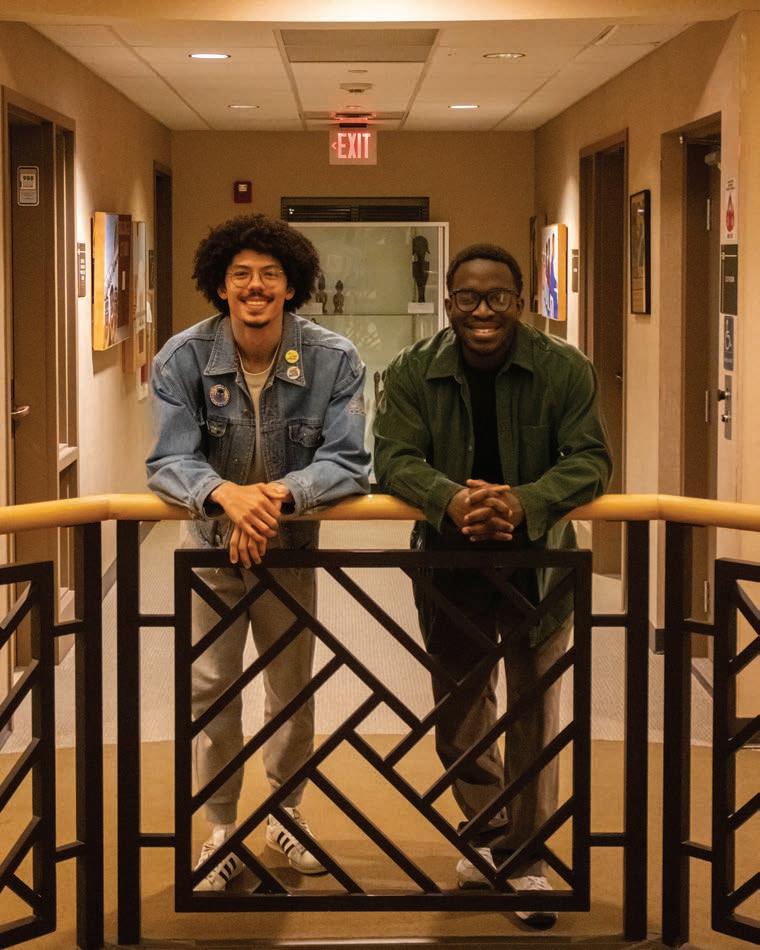
JAMES WALLACE ’26
JUNIOR EDITOR-IN-CHIEF
Over 150 students at Wabash are recipients of the Frank O’Bannon Grant — a state-funded grant aimed at making it easier for Hoosier students to attend college in-state. But the Indiana Education Commission for Higher Education has recommended cuts to the O’Bannon Grants — something Christian Gray ’25 and Jordan Olarewaju ’27 objected to.
“When I first read the email, I just sat on my bed and just stared at the ceiling for a couple of minutes,” said Olarewaju, a recipient of the O’Bannon Grant. “I just gathered myself, thinking ‘What is going on?’”
Even students who were not affected directly by the cuts felt sympathy for their Wabash brothers and saw the need to stand in support.
“Once I saw [the email], I was like, ‘Hell no,’” said Gray. “If someone else is stressing about something, I’m going to try to be there and support them. That moment made me say, ‘Let’s do something.’”
Together, Gray and Olarewaju decided to host a student-led activism event to try to combat the proposed budget cuts. Members of the Wabash community joined together on April 10 in the Malcolm X Institute of Black Studies to write letters in opposition to the proposed state budget cuts to State Senator Ryan Mishler of the Indiana State Budget Committee.
“I, for one, was not going to sit here and let [these cuts] just happen,” said Olarewaju. “The solution we came up with, knowing there were other people affected, was to bring the campus together to help brothers in need.”
ELIJAH WETZEL ’27
FEATURES EDITOR
For the third-straight year,
The Bachelor was named Division III Newspaper of the Year by the Indiana Collegiate Press Association.
On April 12, the editorial staff of The Bachelor made the trek to Indiana University Bloomington, where, following a morning of educational sessions, awards were granted for the 2024 calendar year.
Taking home 17 awards in 15 different categories, The Student Voice of Wabash College earned a total of 53 points, besting second-place The Record (Goshen College) and thirdplace The Torch (Valparaiso University). Despite its lack of a journalism program, a commonplace at the schools Wabash competes with, generations of Wabash students have joined in on one of the school’s oldest traditions and competed successfully with students across the state.
“Wabash men like a good story and they are naturally
curious – asking yet another question comes straight from the work done in classes and labs,” said Wabash Chief of Staff and longtime advisor to The Bachelor Jim Amidon ’87. “That curiosity drives men like Logan Weilbaker ’25 to challenge us – and himself – with a new, difficult crossword puzzle every week. It’s why a tiny school like Wabash has a strong, readable section focused on world news written by several talented writers. And it’s why the best stories every week are profiles – we’re curious about people and our people make the place special.”
After sweeping the contest two years ago and eking out a win by a single point last year, the three-peat felt like a hard-earned victory for The Bachelor’s editors.
“You never know what the competition is going to bring, so the only thing you can control is your own work,” said Weilbaker, The Bachelor’s managing editor.
“We were super in control of

our work this year, having a veteran staff and almost everybody returning for a second year. We definitely wanted to win ICPAs, but accomplishing that was just a matter of taking it weekby-week and making sure that we were doing our best to produce the highest quality content that would give us the best chances at the end of the year.”
After a three-year stretch at the top, The Bachelor staff will aim to keep its run going in 2026. But with or without external recognition of its successes, Wabash’s student voice will continue to skillfully write about what’s important to Wabash and its community members for years to come.
Students, faculty and staff came together to write 25 letters in-person on the day of, and over the course of the next day, an additional 27 letters were emailed in to Gray and Olarewaju, totaling 52 letters addressed to Senator Mishler. The letters were hand delivered to Senator Brian Buchanan — whose district encompasses Wabash — by Gray himself during a legislative breakfast on April 12.
The two Wabash men, along with many other members of the student body, faculty and staff hope the letters may have an impact on the cuts to the O’Bannon Grants. But since the state is still preparing to make these proposed cuts, at least for now, Wabash is looking to the future to prepare for the worst.
“[The cuts] put the College in a precarious situation,” said Gray. “If the cuts go through, the College has to pick up the slack, because they don’t want to lose out on a student they’ve already invested in.”
“We will just make it work,” said Wabash Chief Financial Officer Kendra Cooks. “If Indiana doesn’t want brain drain, if it wants to have a strong workforce and talent, we are working on our relationships to convey that Wabash College makes a difference. We will make the funding work.”
Brain drain is not a new concept to Hoosiers. Ever since a breakout study in 1999 that showed that the college graduation retention rate for the state of Indiana was 30 percentage points lower than the national average, efforts like the O’Bannon Grants have endeavored to make post-secondary education a priority for Hoosiers.
Pre-Law Society celebrates annual Peck Dinner and lecture
Features president and CEO of the National Constitution Center
JACKSON GOODYEAR ’27
STAFF WRITER
On April 17, Wabash hosted the annual Peck Lecture and Dinner, one of the most significant events put on by the Wabash Pre-Law Society during the school year. The two events invite Wabash alumni working in the field of law to come back to campus and convene with current pre-law students.
The Peck Dinner was initially established in 1974, with this year’s dinner being the 51st. Wabash eventually added the lecture to bring distinguished figures practicing law on campus to share their experiences and wisdom.
This year’s attendance for the dinner was around 70 students and 50 alumni. The alumni attending will include those currently in law school, practicing lawyers and current judges. The event is very popular among Wabash alumni that practice law, and attendance is very strong among those who live in central Indiana.
“Only at a place like Wabash can you get all those people together,” said Pre-Law Society President Andrew Dever ’25. “It’s a Thursday night, we’re busy with school and they’re busy with work, but there’s just something special at Wabash that brings everybody together.”
The dinner allows for many to be recognized for their excellence as awards were given out to multiple students and the distinguished speaker. The two most prestigious awards are the Senior and Junior Peck Medals. Traditionally, the speaker is given the Senior Peck Medal and the Junior Peck Medal is awarded to the most outstanding pre-law senior.
JAMES WALLACE ’26
JUNIOR EDITOR-IN-CHIEF
In the annual student body president and chief justice of the Supreme Court elections, Wabash men voted in Austin Pickett ’26 as the incoming student body president and Duc Phan ’26 as the incoming chief justice of the Supreme Court. Pickett won the seat with approximately 66% of the vote in a definitive victory, with McDonald fetching
28% of the
Nearly 6% of all voters abstained from voting for either presidential candidate.
Phan had an easier time, as he ran unchallenged, receiving over 85% of the vote for his position, while 15% of the voters abstained from selecting him. “I am very thankful for the opportunity to represent the student body of Wabash College,” said Pickett. “I look forward to interacting with everyone as we work to make next year an incredibly memorable and exciting year at Wabash.”
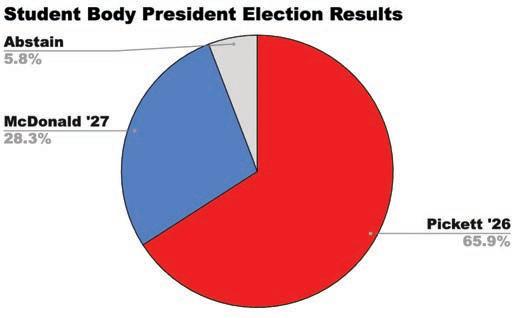

Continued from page 1
As recently as 2024, studies have shown that one year after graduation, 61% of Indiana graduates are working in Indiana, but the proposed cuts to the O’Bannon Grants signal to some students that putting a stopper in the brain drain is less of a priority than in years past.
“They’ve put us in a confusing spot right now,” said Olarewaju. “They’ve pushed the agenda of funding education, but now my grant is getting cut. I’m hoping that with our efforts, we can make a change.”
Another factor adding to the confusion many students are feeling is the fact that the Indiana state government is being headed by recently-elected Governor Mike Braun ’76. While not a part of making the budget itself, Governor Braun still has a say in what gets included and what he approves.
“I like to imagine that Governor Braun had a good experience here,” said Gray.
“So to have that experience, and then to not ensure that other people in the future can have that experience is troubling for me to comprehend.”
The proposed cuts will not only affect the current classes of students that are recip-
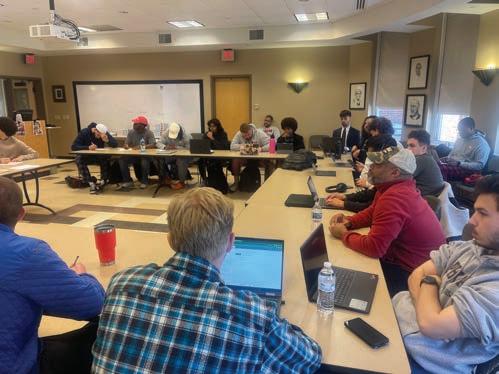
ients of the grant, but also future generations, making it harder for private institutions in particular to fund scholarships and increase enrollment across the state of Indiana.
“The College is funding the vast majority of a student’s scholarship needs here,” said Wabash President Scott Feller. “But the fact is, we can make our scholarship dollars go further if we are leveraging a Pell Grant from the federal government or a state award from the O’Bannon. These allow us to do more and touch more students when we have a partner in the state of Indiana.”
Both Gray and Olarewaju are hoping their efforts, along with 50 other members of the Wabash community, will be enough to make an impact on the proposed O’Bannon cuts, but will have to wait to see if their efforts will be in vain or not as the cogs of the state government slowly turn.
“Activism is like a muscle you have to flex,” said Gray.
“Leading a protest or an activist event doesn’t have to be the first time [you flex it]. It takes us encouraging younger guys to stretch those muscles, and that will lead to community-wide change.”

Continued from page 1
The alumni that attend the dinner are very diverse within the types of law they practice. Wabash alumni are involved in just about everything that there is within the law industry. Wabash’s liberal art’s education fosters this diversity.
“Our Wabash lawyers are out there doing it all, and that’s why this place works for them,” said Associate Professor of Political Science and Pre-Law Advisor Scott Himsel ’85. “If you are forced to learn it all when you are here, you’re going to be so much better prepared.”
This year’s distinguished speaker was Jeffery Rosen,
the president and CEO of the National Constitution Center in Philadelphia, Pennsylvania. Rosen is a graduate of Yale Law School, and now works as an intellectual on constitutional law. Rosen’s work at the National Constitution Center consists of tackling modern day constitutional issues in a non-partisan way. Rosen’s professional goals align with the educational goals of Wabash.
“Wabash is not about telling people what to think about the issues or indoctrinating them into any particular view,” said Himsel.
“What it is trying to do is to get them better equipped to make their own decisions intelligently and be critical

thinkers. Rosen is bringing together people who have different points of view to debate and discuss these issues.”
Rosen isn’t the only one that is focused on the importance of constitutional law. Many classes at Wabash that tackle topics in the law are focused specifically on constitutional law, covering topics within the subject including the fundamental 1st and 14th amendments.
The reason why constitutional law is such a significant topic at institutions such as Wabash is because of how fundamental it is to even our nation’s most complex issues. Grasping the basics of our constitution is fundamental for Wabash students to have before moving onto law school.
“Constitutional law makes up the fabric of our whole country,” said Pre-Law Society Vice President Ben Cody ’26. “If we don’t abide by the Constitution, then nothing matters.”
Events like this one keep Wabash a center for studying the foundational principles of our nation’s constitution. This legacy is what fosters excellence among our prelaw students and the excitement to come back among our alumni.


BEN WALLACE '25 STAFF WRITER
Warfare" is one of the best war movies of the decade so far. It delivers exactly what I look for when I walk into the theater for a war flm: no over-romanticizing, no score or needle drops, just raw sound and unfltered tension. There’s no main character either. Instead, the flm follows an entire squad, giving equal focus to each member as they carry out a mission.
What sets “Warfare” apart is its unique narrative style. The viewer is never given a clear objective or mission summary. We’re dropped in with a group of Navy SEALs operating in Iraq in 2006. One night, they break into a civilian home and turn it into a surveillance post. The next day, we watch them quietly monitor their surroundings, showcasing how exhausting, painful and monotonous surveillance work can be. The flm underscores just how critical constant, skilled communication is for these men, even in stillness.
The action ramps up when the men they’ve been watching attack the home. Chaos erupts. The flm quickly cuts between different members of the squad, highlighting how every individual plays a vital role in their extraction. There’s no Hollywood hero moment, just coordination, fear and survival.
“Warfare” was written and directed by Navy SEAL veteran Ray Mendoza. Right from the start, the flm explicitly states that the story is based solely on the memories of the squad. That creative choice adds a layer of emotion and authenticity. The events may not have happened exactly as portrayed, but the perspective is raw and personal. These memories, however imperfect, feel vivid, lived-in and deeply human.
Another standout aspect of this flm, something rarely explored in modern war movies, is its attention to the impact on civilians and Iraqi soldiers. The Iraqi soldiers play a key
role in assisting the SEALs, primarily by translating during the invasion of a civilian home. However, as the story unfolds, it becomes clear that they’re not truly respected by the SEALs. They’re treated more like disposable tools than allies, essentially used as human test dummies, with little regard for their lives or dignity.
The flm also dedicates meaningful time to the Iraqi family whose home is overtaken. We see them multiple times throughout the movie: terrifed, distressed and powerless. In a particularly powerful moment, the flm returns to them after the SEALs have left. Even in the absence of violence, the fear lingers. Their home no longer feels like a safe place. It’s a haunting reminder of how war permanently alters the lives of those who never chose to be a part of it.
There were also a few moments I found genuinely cool. One was what they called a “show of force,” when a jet would fy low, kicking up dust and making a thunderous sound, which would be used for cover. The flm also includes glimpses of the soldiers’ sense of humor, which added a human layer to the experience. It was nice to see that even in recalling traumatic memories, the squad remembered those small, lighthearted moments too.
To wrap it all up, the flm ends with behind-the-scenes footage of Navy SEALs training the actors on set. It’s a great fnal touch that highlights the effort and authenticity poured into this project.
This movie was made for the theater experience. It features some of the best sound design I’ve heard in a long time; intense, immersive and relentless. Seeing it in a theater, where the sound is booming around you the entire time, makes a huge difference. I highly recommend watching it on the big screen if you can. It’s easily my favorite flm of 2025 so far.
FINAL VERDICT: 4.5/5 WALLYS






ACROSS
1. Healing rubs
6. Seat in a British pub?
10. "Arthur" airer
13. Swahili for "journey"
14. Nation between Thailand and Vietnam
15. Barley wine, e.g.
16. "Everybody out!" — Semisonic
18. Number at the nadir
19. Oodles and oodles
20. Daniel with a coonskin cap 21. Certain athletic award
22. Boulder hrs.
23. Fink
24. "That's a ___!"
26. "That's all!" — Boyz II Men
31. Battle lines?
34. Indulge one's wanderlust
35. Birthplace of bossa nova
36. Take in the sights
37. Austrian painter Gustav
39. Letters in code?
40. Congress creation
41. Fairy-tale opening
42. Western outft?
43. "Bon voyage!" — Green Day
47. SparkNotes content
48. Musical syllables
49. Golfer's goal
52. Un-extinct type of wolf
54. Seize (from)
57. "Enchanted" title girl in a 2004 flm
58. Radio host Glass
59. "Until next time!" — Wiz Khalifa
61. Skybox guest, often
62. Mentally ft
63. Motley
64. Fallout from a volcano
65. Bow-toting god 66. Lets up

DOWN 1. Wads
2. Sherlock's "underway"
3. See it out
4. CAT-scan alternative
5. "Arabian Nights" sailor
6. Female choir member
7. Cause of some delays
8. Tolerably
9. Lingual suffx
10. Stamp collectors?
11. Lit-up dot
12. Like John Krasinski, according to People
13. Almost any "Get rich quick!" offer
17. First-choice
21. Ring bearer?
23. ER staffers 25. Dream state, for short 26. Act humanly, say
KFC center 28. Jerry's partner 29. Sets one's sight 30. Also-ran in ’96

Deer dad
Fashion designer Chanel
Ink
Sweaters and such
Certain TV tech 39. Soil-turning tool 41. Hosp. trauma centers 42. Dell and HP products 44. Game cube
45. "What's more..." 46. Word after "force of" or "freak of" 49. China purchase 50. Nom de plume 51. Buzzed 52. Hard-to-please celeb 53. Pupil's setting 55. City north of Carson City 56. Surveillance metaphor
Objects of an Easter hunt
Chicago-to-Indianapolis dir. 60. Grp. to call for a tow



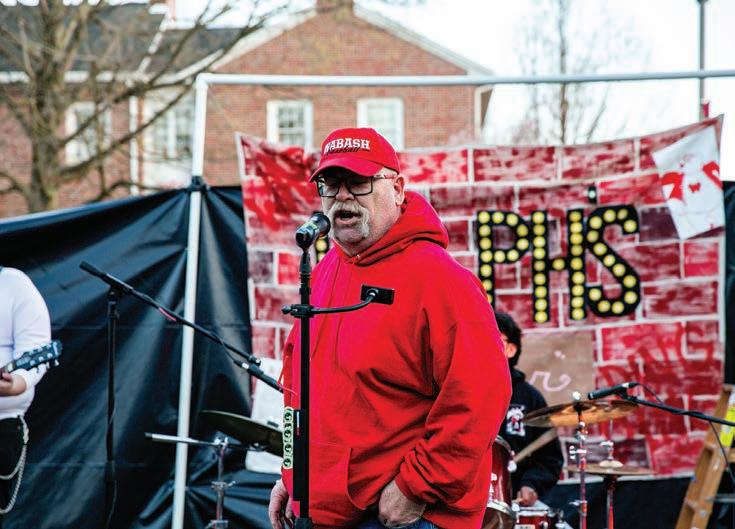

Despite rising expenses due to USAID cuts, The Bill Cook Foundation remains focused on its mission
ELIJAH WETZEL '27
FEATURES EDITOR
Some people prefer quiet, easy living. Bill Cook ’66 does not. That’s why he founded an international aid foundation when he was in his seventies.
An Indianapolis native, Cook graduated from Wabash in 1966 before heading to Cornell University and earning his master’s degree and PhD in medieval history. Professionally, Cook spent over forty years as a college professor. Most of that time was spent at the State University of New York (SUNY) in Geneseo, New York, but he also returned to his alma mater to fll a position in Wabash’s religion department for two years after legendary professor Bill Placher ’70 died in 2008. Cook is also the foremost scholar on Saint Francis of Assisi.
Cook is also an accomplished philanthropist and public servant. He served on numerous boards and committees at SUNY, led immersion trips for Wabash students and alumni, stood for election to Congress in New York, wrote a weekly newspaper column for over a decade and has raised hundreds of thousands of dollars for Covenant House, an organization that supports homeless youth. On top of it all, Cook founded the Bill Cook Foundation in 2015, a group that helps some of the poorest children in the world gain access to the best education possible.
“The foundation is really just the latest manifestation of Bill’s long history and commitment to making the world a better place,” said Professor of Classics Jeremy Hartnett ’96, a close friend of Cook’s for decades. “Bill has always been somebody who lived out his faith without talking a lot about his faith and who targeted education and taking care of people who have had a rough time of it.”
The Bill Cook Foundation seeks to operate with as little overhead as possible and works directly with programs and children in need. Whereas larger philanthropic or-

ganizations like the Gates Foundation or the Rockefeller Foundation approach solutions to poverty at the system-level, Cook’s foundation seeks out people in some of the world’s poorest areas whose immediate needs are greatest — places where a little money goes a long way.
So far, the Bill Cook Foundation supports people in over twenty countries across the globe. These projects include a high school for teenagers in South Sudan — many of whom have at one point in time been displaced by violence in the region — named Bill Cook High School, in honor of the man who helped fund it. The Foundation aids women who were forced to be child brides in Zimbabwe, offering them childcare and job-skills training, established a jungle medical school in Southeast Asia, founded the frst

and only high school for deaf teenagers in Equatorial Guinea and completely funds a program of Wabash’s Global Health Initiative that partners with Corazones Excepcionales in Peru to educate children with Down Syndrome. Corazones Excepcionales directly serves around thirty kids, and Cook’s foundation pays for them all, about $20,000 each year. 30 children may not seem like a big impact, but it’s an impact that reverberates.
“That’s pretty cheap, right?” said Cook. “But the people who beneft are far, far beyond just the kids — it’s the parents, the neighbors and the larger community. It also takes some of the stigma away. A lot of these kids had never been out of the house before our program, essentially, so nobody knew there were that many Down syndrome kids around.”
Much of Cook’s philosophy stems from his Christian faith and study of Saint Francis, who spent much of his time with the poor, often impoverished himself. For Cook, joining people in their experience of life is often crucial to loving them to the fullest extent of their humanity. He referenced a story that depicts Francis gingerly dropping money in a leprous beggar’s hand so as not to get too close, but after refecting on his choice to distance himself, sought out another leper, embraced him and gave him money. After that, Francis recounted, it was easy to leave the world — meaning, after that, it's easy to adopt the values of God rather than the values of humans.
“It’s not about money,” said Cook. “It’s not about my picture in the paper. It’s not about any of that. It’s simply for love. To me, that’s what’s important. It’s ‘this person,’
not ‘this leper.’ Making that move, in most cases, requires being on the ground with people; not reading about it, not studying it, maybe not even praying over it. You really need to experience it.”
Now 81 years old, he’s still indefatigably fueled by a passion for those on the margins, traveling the world to visit his foundation’s projects and spend time with the children he supports with his work. Over the past decade, the Bill Cook Foundation has given away around $4 million. His radical motivation to meet the needs of the world’s most impoverished citizens burns on.
“He’s mission-driven,” said Hartnett. “In part, he just enjoys the challenge of it. But I still remember him telling me one time when I was growing up, ‘You should not let it slip past you how incredibly lucky you are to be born where you are, with loving parents, with safety, with food, with education, et cetera.’ There's a part of him that, when he sees injustice, he deeply wants to tamp it out. It’s also impossible for me to imagine him sitting still. He burns bright and loves collecting stories and doing his little bit to improve things.”
Cook’s work is especially valuable now. In February, the Trump administration announced it would cut more than 90% of the U.S. Agency for International Development’s (USAID) foreign contracts, eliminating $60 billion in aid to marginalized people around the globe. Experts predict the cuts in aid — which funded a multitude of ventures in global health, poverty alleviation and education, among other philanthropic investments — will hurt everyone because of the inevitable spike in untreated health problems and downstream econom-
ic impacts of a less-educated global economy, but especially the most disadvantaged, the very people the Bill Cook Foundation serves. The Foundation is already feeling effects from the cuts.
“When we built a school and hired the teachers, USAID provided the food and the teacher salaries,” said Cook. “Without that additional expense, we could go and build another school. Once word got out [about USAID’s dismantling], teachers basically came and said, ‘We’re going to quit unless you can guarantee we’ll have our salary. We’ve got to fnd jobs somewhere else.’ We ended up sending about $25,000 to support some teachers right away. I also just sent $10,000 to schools in Kenya for food. We don’t usually have to pay for food, so it works on a number of different levels. It’s not just the teachers or the building, and it’s not just the food. It’s all of the above.”
Cook is grateful that his donors, whom he crisscrosses the country to meet with and ask for donations when he’s not meeting with the children their money supports, have been able to meet the increased needs thus far, but he worries about the direction the USAID cuts indicate the country is heading.
“I believe that the democratization of the world, with all the attendant freedoms, is slow and painful — two steps forward, one step back,” said Cook. “I think inevitably, we’re going to win out, but I’m not as confdent now as I was even a couple years ago. You can’t lean back and assume that’s the way the world’s going to evolve. You’ve got to take action.”
Cook and his foundation have chosen to take action in the exploited and diminished areas of the world. Relative to the massive disease of poverty in the areas he works, Cook’s efforts could be viewed as meager, only a miniscule dent in the grand scheme of inequality and sorrow. But that view would undersell the literally life-changing contributions his foundation has made to thousands of people who now look forward to slightly brighter futures. That, and Cook is playing the long game, making his impact on one community at a time.
“Ultimately, I’m in the seed-planting business,” said Cook.
“Bill’s message is perennially important,” said Hartnett. “It’s that when you see a problem, an injustice in the world, you can attack it with ferocity and try to make it better. Bill’s inspirational in that way.”
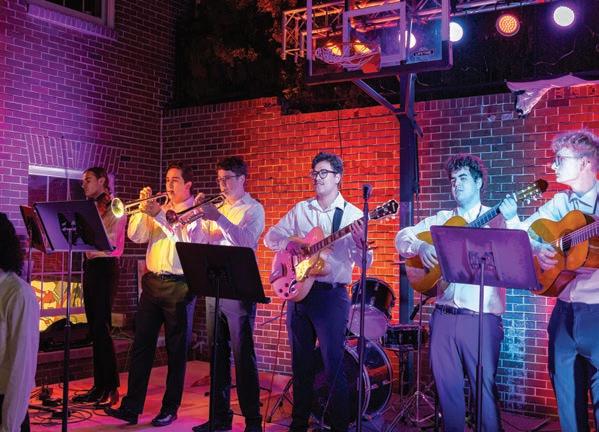
OWEN VERMEULEN '28 STAFF WRITER
Most of us have probably felt homesick in one way or another at some point,especially during college. But how do you deal with that? If your name is Alejandro Cruz ’27, you bring a bit of home with you. Last year during Cruz’s freshman year, he started Wabash’s frst mariachi band. The group, Los Pequeños Gigantes, has been an ever expanding part of the Wabash music community since coming on campus in 2024.
The mariachi band is a traditional Mexican music ensemble that Cruz wanted to bring to Wabash since before he even arrived on campus. It has helped connect him to his home in south Texas as well as with fellow members of the hispanic community on campus. The story I always point back to is when Tyler Wade was talking to me and my family when he was on a recruiting visit to McAllen, Texas” said Cruz. “We were talking about how I was a part of the mariachi at my high school and he said, ‘Well, you could start a mariachi at
Wabash.’”
This idea stuck with Cruz until he fnally arrived at Wabash and was able to turn his idea of bringing mariachi to Wabash into a reality. For almost a year, mariachi was completely student-run, with Cruz taking on the bulk of the work organizing and training the group. Now Los Pequeños Gigantes is integrating into Wabash’s music curriculum. It will join the fve credit-eligible ensembles that already exist on campus: Orchestra, Brass Ensemble, Jazz Ensemble, Wamidan World Music Ensemble and the Glee Club.
Now that the mariachi band is becoming an offcial part of the Wabash education, they will be receiving more professional guidance. The frst wave of this came in the form of Choral Director Juan Hernandez, who became the advisor for the band this year.
“I think that having a professional lead the ensemble is going to help push the group to a new level,” said Cruz. “I’ve done all that I can, but I am limited professionally and musically. Having Dr. Hernandez come in and teach the lessons is going to help the ensemble progress a lot faster and grow to a new level.” Hernandez has been adjusting to the new form of music that comes with the mariachi. While Hernandez has graduate degrees in music, he has not had the experience of directing a mariachi before.
“Alejandro started the whole thing, so he has been introducing me to the things that are more specifc to mariachi,” said Hernandez.
“Learning how the music is supposed to sound has been a new and exciting challenge. I’ve been enjoying teaching and learning this different type of music.”
With Cruz’s knowledge and hands-on experience with mariachi and Hernandez’s expertise in music working in tandem, Los Pequeños Gigantes has been making massive strides. The group's ever expanding potential comes with ever expanding goals. Cruz and Hernandez would be the frst to tell you that their aspirations extend even beyond Wabash.
“Having a director that will help us seek out a bigger repertoire and teach it more effectively has been a massive step forward,” said Cruz.
“This will create an opportunity for us to start memorizing the music and engage campus with more concerts and then allow us to share our music with the Crawfordsville community more effectively. I was very surprised to see the Latino presence in the community and hear that it’s a growing demographic, so it’s super important to me to share this music with the Crawfordsville community.”
“Now that the mariachi is an offcial ensemble offered by the music department, where as before we were just testing the waters, now things are in full motion,” said Hernandez. “We are currently in the process of trying to hire an adjunct professor. Someone that can take over the ensemble and knows the specifc techniques and rhythms of mariachi.”
With all the positive momentum the group is carrying, it is very likely that you will be seeing more from Los Pequeños Gigantes in the years to come. They hope to not only expand the range of liberal arts education but also expand the range of Wabash’s impact on the Crawfordsville community.
“Mariachi can serve as a destressor and a creative outlet that balances any kind of analytical thinking that happens in Goodrich, Baxter or Hays,” said Cruz. “We’ve defnitely had a lot of fun playing the music, but we haven’t held up our end of the bargain community wise. There’s a lot more we can do for the community, and that’s our goal.”
With all the improvements that the mariachi has made already, one would be content to let good enough be. However, the College is not done trying to further their support of mariachi.
301 W. Wabash Ave.,
Crawfordsville, IN, 47933
X: @bachelorwabash
IG: @bachelorwabash
EDITOR-IN-CHIEF
Sam Benedict • ssbenedi25@wabash.edu
MANAGING EDITOR
Logan Weilbaker • laweilba25@wabash.edu
NEWS EDITOR
James Wallace • jpwallac26@wabash.edu
EDITOR
OPINION
Preston Reynolds • pcreynol25@wabash.edu
FEATURES EDITORS
Elijah Wetzel • ejwetzel27@wabash.edu
Ty Murphy • tmmurphy27@wabash.edu
SPORTS EDITOR
Ethan Wallace • ewallac25@wabash.edu
PHOTO EDITORS
Elijah Greene • eagreene25@wabash.edu
Will Duncan • wjduncan27@wabash.edu
The purpose of The Bachelor is to serve the school audience, including but not limited to administrators, faculty and staff, parents, alumni, community members and most importantly, the students. Because this is a school paper, the content and character within will cater to the student body’s interests, ideas, and issues. Further, this publication will serve as a medium and forum for student opinions and ideas.
Although an individual newspaper, the Board of Publications publishes The Bachelor The Bachelor and BOP receive funding from the Wabash College Student Senate, which derives its funds from the Wabash College student body. Letters (e-mails) to the editor are welcomed and encouraged. They will only be published if they include name, phone, or e-mail, and are not longer than 800 words.
The Bachelor reserves the right to edit letters for content, typographical errors, and length. All letters received become property of this publication for the purposes of reprinting and/ or redistribution. Profanity may appear in the publication, but only in cases of direct quote or if profanity is necessary to the content of the story. Please do not confuse profanity with obscenity. No article or picture of an obscene nature will appear in this publication.
The Bachelor is printed every Thursday at the Purdue Exponent in West Lafayette. It is delivered freely to all students, faculty, and staff at Wabash College. All advertising published in the Bachelor is subject to an established rate card. The Bachelor reserves the right to deny requests for publication of advertisements. Student organizations of Wabash College may purchase advertisements at half the listed rate.
The Bachelor is a member of the Hoosier State and Indiana Collegiate Press Associations (HSPA and ICPA).



WJulius Hearns ’25
Reply to this opinion at jphearns25@wabash.edu
abash College holds the Gentleman’s Rule as a badge of honor — a single sentence that’s meant to guide every student’s behavior on and off campus: “The student is expected to conduct himself at all times, both on and off campus, as a gentleman and a responsible citizen.”
It’s simple, clean and timeless…or so we’re told. But what happens when something meant to define our values becomes a shield that excuses inaction?
The Gentleman’s Rule sounds noble. It implies respect, integrity and personal accountability. In theory, it asks us to rise to a higher standard not because we’re forced to, but because we believe in doing the right thing. But in practice, the rule is vague, outdated and inconsistently applied. And that’s not just a flaw in the wording, it’s a failure of responsibility.
The issue isn’t that the rule asks too much of us. It’s that it doesn’t ask enough of the institution itself. When students harm others, cross boundaries or engage in behavior that violates community trust, there’s rarely a clear, transparent process for accountability. The Gentleman’s Rule is cited often but enforced selectively or as you guys call it, “case by case.” Who decides what counts as “gentlemanly?” Who gets protected by that standard, and who gets ignored?
Too often, the answer depends on status, identity or silence.

We will be running the last issue of the Bachelor next week!
If interested, contact pcreynol25@wabash.edu

Rodolfo Elizondo Alcala ’27
Reply to this opinion at ryelizon27@wabash.edu
I like Hawaiian Pizza. If this is a big deal to you, I recommend you stop reading this opinion piece because I am going to speak a lot of truth on this: Pineapple belongs on pizza. If you read last week’s article in the Bachelors, you might have come across an article titled “A Culinary Abomination: Pineapple on Pizza.” Like many Wabash students, I sat down and read some of the always good writing from the Bachelor’s after a long day of being a Wabash student. But that article was the last drop for me.
Let’s be honest, vagueness benefits power. When there’s no detailed code of conduct, there’s more room for discretion, and with discretion comes bias. Students from marginalized backgrounds, including Black students, LGBTQ+ students and others who already face higher scrutiny, are left wondering whether the Gentleman’s Rule is really for them or just another way to uphold tradition at their expense.
Wabash can’t keep hiding behind tradition. The Gentleman’s Rule, as it currently stands, is lazy rhetoric. It’s a feel-good phrase that allows the College to present a moral high ground without having to do the hard work of defining, teaching and creating systems that foster shared values. It’s one thing to tell students to act with integrity. It’s another to create systems that actually hold us to it both equally and transparently.
This isn’t a call to throw away the Gentleman’s Rule. It’s a call to give it weight. If we truly believe in the ideals behind it, we need to have honest conversations about what it means to be a “gentleman” in 2025. We need to create space for all students to feel respected, protected and empowered to speak up. And above all, we need accountability not just for individuals, but for the institution itself.
Wabash can’t build its reputation on character while refusing to confront the ways it falls short. It’s not enough to recite tradition: we have to live it, question it and improve it. Being a gentleman should mean standing for something real. And that starts with standing up for what’s right even if it means going against one of the most prestigious traditions this institution holds.

THINGS WORTHY OF A HI-FIVE THIS WEEK
STEPPING IN AT 6’3” AND 215 LBS...
Hi-five to the Oscars for announcing the addition of a stunt category. For doubling roles involving dangerous stunts like attending a routine physical, DK Metcalf better come home with that trophy.
Lo-five to whoever *coughdanniescough* stole the baseball team’s jerseys. Maybe it’s time to remember who our enemies are...
Lo-five to Katy Perry for taking an 11-minute trip to space. If this an attempt to inject her waning career with a little media coverage, we predict it will last about 11 minutes.
Lo-five to JD Vance for dropping and breaking the CFP National Championship trophy. The trophy almost fell as fast the economy!
Hi-five to the stinky rhynes for trading their green limbs for scarlet and white stripes. At long last, our skies are safe.


Here’s the truth: I like good Pizza. I like toppings, I want flavor, and pineapple is no exception. Pineapple belongs on Pizza; as a matter of fact, so do olives, mushrooms, peppers, spinach, kiwi and ketchup. Everything belongs to pizza. The hate pineapple on pizza gets isn’t really about the flavor. It’s about people that follow trends without haven’t even tried pineapple on pizza. Pretentious foodies will argue for the traditional way of eating pizza, a simple dough base with a tomato-based sauce and a few slices of mozzarella and a simple topping like pepperoni. However, this is not entirely true. Like most countries, Italy is rich in regional differences, and the way to make pizza is no exception. The description above is the Napolitano way of making pizza that originated in Naples. And everywhere else in Italy pizza has different topping and cooking procedures. If you were to travel to Rome and order
a pizza you wouldn’t receive the iconic circle pizza you would get a rectangle and be sold by a square slice. So, not even in Italy is there a single traditional pizza. As much as I love pineapple on pizza, I love the story of its creator, a story of combination of cultures and experiences. Pineapple on pizza was started in Canada by Sam Panapoulous, a Greek immigrant who moved to Ontario. Sam decided to innovate, and was inspired by Chinese cuisine in America, which mixed sweets to highlight the flavor. Sam decided to open a can of pineapple slices from the “Hawaiian” brand and invented the controversial but delicious “Hawaiian pizza.”
Another argument people make against pineapple on pizza is that the flavor is a clash between salty and sweet. That is a lie. Sweet and salty combinations are some of the best combinations on dishes. Have you ever had peanut butter and jelly? Sweet
potato casserole? Chicken and waffles? Mango with Tajin? Chocolate pretzels? Korean BBQ or BBQ ribs? These dishes are the most delicious and are salty and sweet. If you think your pizza is floppy, soggy or unbalanced from the sweet and salty flavors, I recommend switching the place you get your pizza from. To conclude, the real people we should hate are people telling others what they should eat. Put whatever you want on your favorite pizza. You are the one who will eat, not anyone else. Enjoy your pizza any way you wish. Put on onions, sausage, olives, mushrooms, ham, pineapple or anything else you find in your kitchen. Make it yours. Make it fun and make it unique. But please don’t put cottage cheese on pizza, that’s disgusting.

WJackson Leeper ’25
Reply to this opinion at jcleeper25@wabash.edu
hat up, bozos? It’s your favorite big back, Jackson Leeper. I hope y’all are doing well and have full bellies. Since last week’s review, I have done nothing but eat. I am a retired collegiate athlete now, and wanted to take a week off. I healed my body through lots of late night eating and having some yummy beverages (love to see those mountains turn blue). As much fun and gluttonous behavior I had, I did gain some weight, but that’s okay. I’m willing to suffer the consequences from my actions. I did hop back on the wagon and started going back to the gym this week so I am still able to eat like a pig and not worry about it. But enough about me, I got another review cooked up.
This week’s review is Yamato. It is a Japanese restaurant across from Culvers and in the same shopping area as Lil’ Caesars. I’ve heard some good things about this place, but I thought it was just sushi, which I’m not the biggest fan of (I know, it’s sacrilegious to not like sushi). However, after looking at the menu, it’s much more than that. Not only do they serve sushi but they have appetizers, hibachi, noodles, fried rice and other classic Japanese dishes.
Most of their items range between $6-$25, with the expensive stuff being filet mignon and other expensive meat. I’ve been here another time and it was a good experience, but I got something that I normally wouldn’t get and it wasn’t my favorite. However, I’m always ready to give a place a second chance as it might have been a bad day. With this in mind, I put on my big boy pants and got ready to clear stock.
The order was this: Shumai (Japanese fried dumplings), chicken fried rice and a firecracker roll, which has shrimp tempura and spicy crab on top. This order was priced at $32. I started with the Shumai and the review started off good. I couldn’t tell what was in the dumplings but my guess was pork. They were light, crispy and tasty. The next thing I tried was the roll. Now, I was hesitant on getting this but I felt I would get criticized by the sushi lovers if I didn’t get sushi. This was the only one that sounded appealing so be happy for being considered “sushi snobs.” I ate a piece and it was okay. The firecracker roll had some spicy mayo sauce which was good and gave good spice but the crab was a weird texture. It was more of a paté and it was questionable. Other than that, the roll had great texture with the rice being soft and the tempura being crunchy. I think this roll would please others much more, but like I said, sushi isn’t my thing so I might be biased and being harsh.
I moved on the chicken fried rice and it was really good. You know you’re having good Asian cuisine when you’re already full but you keep eating because it makes you hungry. I always find fried rice makes me keep eating and I don’t know why but I’m not complaining. The fried rice was cooked and seasoned well. The chicken was abundant and tasty. There were bits of pieces of eggs and veggies, which added some different flavors and textures.
Overall, pretty solid fried rice. Now, after having this meal, I interpreted the data and came up with a review. I give Yamato a 7.5/10 burbers (knowers will know). The food was good, a safe option if you want something different to spice up your meal experience. Join me next week for the last edition of Leeper’s Lunch!



Interested in featuring your art in the Bachelor? We are looking for new artists to be consistently featured in the Opinions section!
Are you interested in making comics? Do you want your art to be featured in The Bachelor?
Contact pcreynol25@wabash.edu or ssbenedi25@wabash.edu
Looking for inspiration? Here is a beautiful 2023 Homecoming comic from Preston Parker ’26.


ELIJAH GREENE ’25
PHOTO EDITOR
In the 21st century, it is a rare honor for a Wabash team to claim their frst-ever victory over DePauw. Unfortunately for the Wabash lacrosse team, that honor will have to wait until next year, at least. In front of a full Wabash crowd in Greencastle on April 15, the Little Giants squandered a commanding 7–2 frst half lead and allowed the Tigers to score seven unanswered goals and steal the win, 9–8.
“It’s a rivalry game, right?” said Head Lacrosse Coach Chris Burke.
“And in those games, it doesn’t matter how much more talented a team is than the other, they both come to fght. [DePauw] won the second half and put it in the back of the net at critical times. We just couldn’t execute.”
Since the team became a sanctioned varsity sport in 2015, Wabash lacrosse has yet to garner a win against the Tigers. On paper, this should have been the year to do it. The two teams have historically been close in the North Coast Athletic Conference standings, with DePauw placing seventh and Wabash placing eighth overall for the past two seasons. But with Wabash boasting a 7–7 record compared to DePauw’s 5–7 as well as averaging almost a goal and a half more per game this season, it seemed that this could have been the year for the Little Giants to break the seal.
And judging from the frst half, it looked as if Wabash would do it. Despite both teams coming out of the locker room keyed up on nerves, it was the Little Giants who settled into the game’s rhythm frst. Capitalizing on the energy from two frst-quarter goals netted by Quinn Fitzgerald ’26, Wabash jumped out to a 5–1 lead halfway through the second quarter, and it looked like the Little Giants had control of the contest. However, that control would be short-lived.
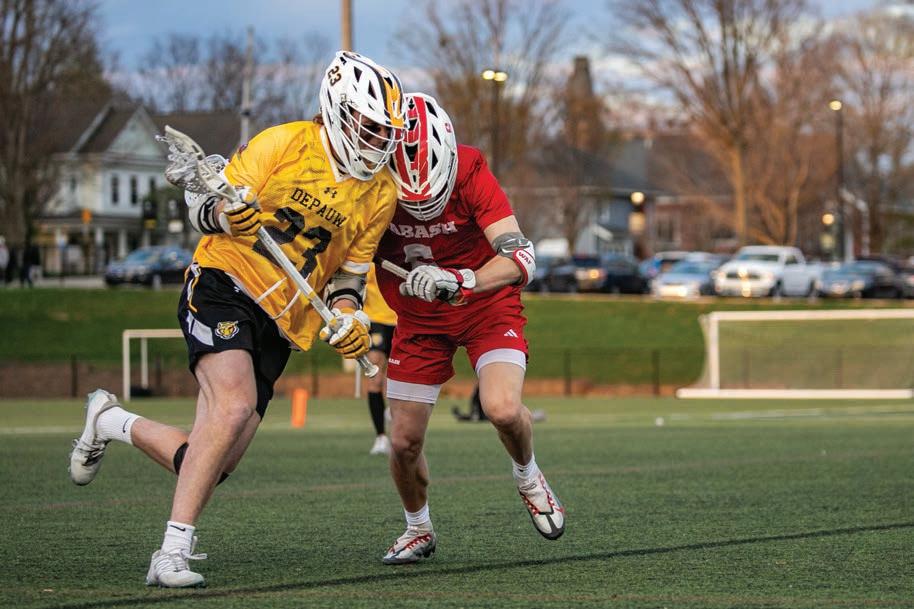
BY ELIJAH GREENE ’25
(Above) Midfielder Nate Jones ’27 jockeys with a DePauw attackmen during the second half of Wabash’s game against DePauw on Tuesday, April 17 in Reavis Stadium.
(Right) Attacker Evan Bair ’28 digests the loss in the locker room postgame.
“That night’s a big game,” said defenseman Bryce Poling ’26.
“Obviously the nerves are going to be high. After the frst quarter, that usually goes away, but rivalry games are a different breed. There are so many emotions going on, and I think that got to both sides. It was obvious that guys couldn’t hold on to the ball.”
Communication and execution are two hallmarks of any sport’s game plan, and the Little Giants lacrosse team was no different. Con-
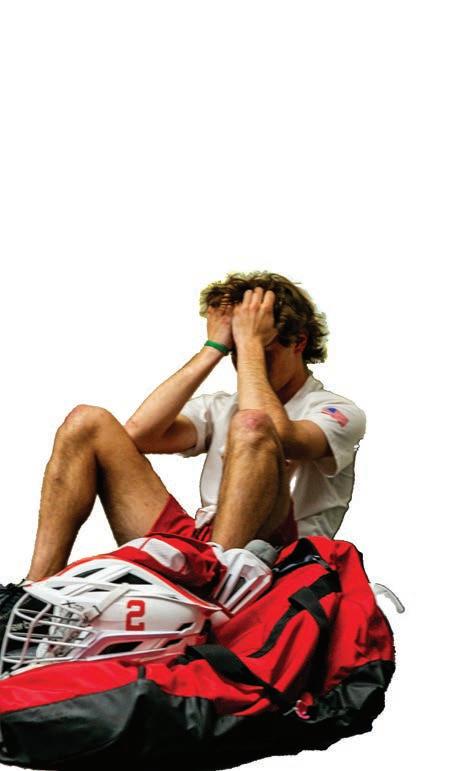

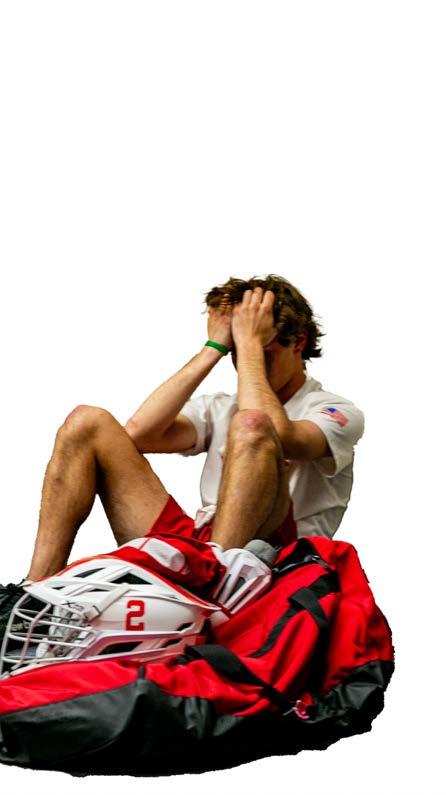
stant information relay between players helped the Wabash defense limit the DePauw offense to just two goals on 12 shots in the frst half.
“In the frst half, we came out and were yelling,” said Poling. “We were being loud. We were telling people what we were doing, and everybody on the feld was on the same page. But in the second half that just went away.”
Communication wasn’t the only thing that the Little Giants left in the frst half; they left their com-
ETHAN WALLACE ’25
SPORTS EDITOR
The usual suspects led Wabash to an eighth-place finish at the 120th Little State Championships. The meet was hosted by Indiana Wesleyan University from April 11-12, bringing together 18 teams from DI, DII and DIII.
The invite gave Wabash a chance to face high-level competition as the North Coast Athletic Conference Championships approach. Across two days of competition at the Little State meet Wabash’s season leaders continued to shine.
On the frst day of competition Wabash only had a handful of chances to compete but found points early to start the meet.
Brayden Curnutt ’25, who seemingly can’t go one week without doing something notable on the track, fnished frst in the 10,000-meter race with a 31:18.96 fnal time.
Jake Oostman ’25 sent the javelin 45.36 meters for a seventh-place fnish. Quinn Sholar ’26 was one spot away from scoring points as he recorded 14.97 meters in the shot put.
The second day of competition gave Wabash several more scoring opportunities, and the Little Giants found success across multiple events.
Wabash’s extremely consistent throwing team found several top-10 fnishes at the meet. Lane Brockman ’26, Will Boas ’26 and Sholar fnished ffth, seventh and ninth in the hammer throw. Brockman’s 49.69-meter toss was a career best.
“Our success at Little State was the result of consistent effort, both in the ring and the weight room,” said Boas. “We’re a tight-knit group that holds each other accountable and makes sure no one falls behind. What sets us apart is the unique bond we share and the drive we bring every day.”
In the 800-meter race, Will Neubauer ’25, David Adesanya ’27 and Haiden Diemer-McKinney ’26 fnished second, third and ffth respectively. All three have recorded top-50 times in the event for Division III. The

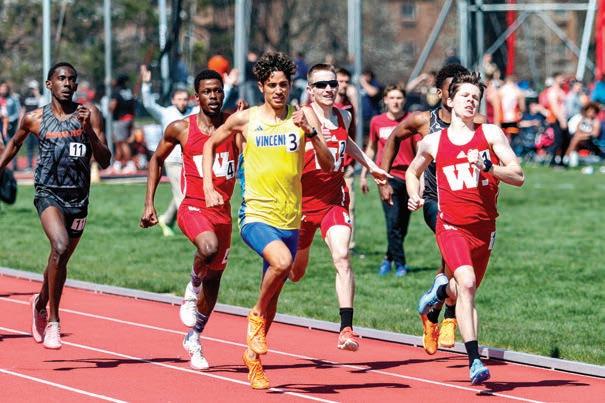
COURTESY OF WABASH ATHLETICS
(Top) Carter Leininger ’28 hands the baton off to Julius Hearns ’25 in the 4x100-meter relay. (Bottom) Will Neubauer ’25, David Adesanya ’27 and Haiden Diemer-McKinney ’26 hit the last stretch of the 800-meter race. The Little Giants competed in the 120th Little State Championships from April 11-12 at Indiana Wesleyan University.
trio also partnered with Owen Smith ’27 to fnish third in the 4x400-meter relay with a fnal time of 3:22.33
“I believe we all did really well at the Little State meet but there’s always room to improve and to prepare to take the next step forward,” said Adesanya. “The next few weeks we will be focused on preparing for the postseason but we’re also just taking it step by step.”
Nate Joven ’26 and Will Morris ’25 went sixth and eighth in the pole vault. Joven cleared a max height of 4.50 meters for a career-best fnish. Sly Williams ’26 fnished sixth in the long jump. Wabash fnished the meet with
48.50 points. For their next outing, the Little Giants will take on the Indiana State University Gibson Family Invitational. The meet will serve as one of the fnal chances for Wabash athletes to qualify for the NCAC Championship meet, which will be held on May 2-3 in Greencastle. “This meet was valuable preparation for the level of competition we’ll face at the NCAC Championship,” said Boas. “Our conference is stacked with talent, and every point will have to be earned. Getting exposure to that intensity now is essential for us to perform at our best when it counts.”
game, I think that gives us a couple more goals and maybe a couple more clears. That could have swung things in favor of us, but at the end of the day, you can’t look past the basic rules of the game. I don’t think we did that quite as well as we normally do.”
“We had 10 turnovers in the frst half and 16 in the second half,” said Burke. “There’s the story right there. Our whole team just didn’t, just couldn’t, execute. When that happens, the ball’s going to end up the other way.”
DePauw’s comeback was not sudden, either. As the Little Giants struggled to clear the ball out of their own half, the Tigers’ consistent pressure and man-marking, as well as several untimely Wabash penalties slowly shifted the momentum in their favor. But by the time the Tigers scored the winning goal, only two minutes remained on the clock for Wabash to respond.
“We couldn’t stop [them],” said Burke. “I realized that the energy was fuctuating towards them. We have a really young team, and they haven’t been in this type of scenario yet. I’m glad our guys battled, but I think we fell apart in the second half.”
petitive spark, too. Other than a goal scored by Jake Pippen ’26 early in the third quarter, the Wabash offense was nonexistent for almost 26 of the 30 second-half minutes. Marked by a multitude of turnovers and extensive time spent on defense, the Little Giants’ lackluster energy and inability to execute in the clutch cost them the game down the stretch.
“We took the fundamentals for granted,” said Poling. “If we sharpen those up a bit throughout the
As much as a loss to DePauw can feel like the end of a Wabash team’s season, the Little Giants still have two more conference games to play: one against Hiram on April 19 and the other against Wooster on April 26. With two wins in the next two weeks, Wabash lacrosse still has a chance to bounce back and tally the most conference wins in a season in program history.
“We could look at it two ways,” said Burke. “We could look at it as our season’s over and move on with negativity, or we can turn into a positive and take it to Hiram, take it to Wooster and maybe ruin someone’s season. Ultimately, it’s going to be up to the guys to decide if they can lift their heads high and get through this.”
TY MURPHY ’27
FEATURES EDITOR
It has been a long and trying season for the campus loved Wabash rugby club. And as they come to the end, it certainly did not go as they expected. After playing in the Notre Dame Fighting Irish Invitational, the team placed ffth out of all small college teams, putting them just outside of range for an automatic bid to the national tournament.
With plans to beef up their resume, the team was set to travel to St. Louis, and face off in the Pharmaceutical 7s tournament. But the weather had different ideas.
“That tournament got rained out, so we were unable to travel and play,” said Rugby Club President James Wallace ’26. “It was particularly frustrating, because that tournament had a lot of Division I and Premier League teams which would have given us a shot to go out on the feld and really beat some strong competition and prove ourselves.”
Not all was lost, however, as the team was set to compete in the Allegheny Rugby Conference Tournament on April 12. But with the last chance to add a high-level performance to their resume before the National Collegiate Rugby (NCR) committee made their fnal picks for nationals, disaster struck.
“Unfortunately, the day before the tournament we heard that the referee they had scheduled for the event had a family emergency, so they pushed it back to Sunday, April 13,” said Wallace. “But at that news, three of the six teams that were felded dropped out, and we realized that with a shrinking amount of competition the tournament was not going to happen.” Soon after, the team would fnd out that the NCR would not select them for an automatic bid to the national tournament. While devastated, the team refused to let the situation get to them.
“We’re in the works of a tournament on April 27 in Mud Hollow right now because we don’t want to end the season on two cancellations,” said Wallace. “And this would just be focused at giving the guys a fnal chance to get another tournament and show other teams that when they come to Wabash they only have us on their mind because we’re the team to beat.” It would be easy for them to be down, having never got their
chance to show why they deserve a spot in the national tournament, but, for this team, it’s different. Their hopes are still up as they plan to play in front of their frst home crowd in months.
“The energy is high,” said Vice President and Assistant Coach Tanner Quackenbush ’26. “We’re excited to play in front of our home crowd, fnally. After all the setbacks, everyone’s just ready to compete and end the season on a strong note. It’s our last chance this season to show what we’re made of, and we want to leave it all out there.” As the tournament details are still being fnalized, the excitement within the team is only growing. With a home crowd in front of them, some will seek to prove to the school and themselves just how good they are.
“What I’m excited to watch is there’s a couple of guys who haven’t scored yet under Head Coach Kelly Romano,” said Wallace. “I can’t wait to see those guys get their frst tries and the crowd and everyone else will be able to see how excited we are for them. It’s going to be pretty exciting for the fans to experience that with us.”
The April 27 tournament will conclude the season for the rugby club, but it will not be forgotten easily. Each player is taking precious lessons from their time with this team.
“It’s huge,” said Quackenbush. “Finishing strong sets the tone for everything that comes next. A good showing here helps build momentum going into the offseason and shows other teams, and ourselves, that we’re serious about making a run next year.” As the season winds down, the team is not only focused on their future but also on savoring the fnal moments with a group that’s become exceptionally close.
“I’ve been a part of this team for three years, and I’ve never seen a team as tight as ours,” said Wallace. “I’ve been on other sports teams in the past, and it’s not nothing like the connection all of our players have with each other. So, it has been disappointing, and it’s been a tough pill to swallow, but we are excited to host. We are really excited to host and be able to put on a show for the Wabash community.”
ETHAN WALLACE ’25
SPORTS EDITOR
The breakthrough will have to wait another year. As Wabash has rebuilt its tennis program, one of the growing hopes has been that the Little Giants could break their 50-year losing streak to DePauw tennis.
On Wednesday April 16, the team came agonizingly close when they lost 3-4 to DePauw. The match, held at Crawfordsville High School’s 11-court tennis complex, showed that Wabash is close but not quite ready to make program history.
DePauw seized momentum in the contest early, sweeping doubles to earn their frst point.
“We know that we’re maybe a more singles oriented team than most teams, so we’re used to losing that doubles point,” said Captain Cole Shifferly ’26. “We love coming out winning doubles points. But even when we lose a doubles point, [the other team] is still going to have to win at least three singles matches.”
Shifferly at 1-singles and Augusto Ghidini ’26 at 4-singles were the frst down, leaving Wabash trailing 0-3. Shifferly’s 6-4, 6-4 fnish was a tight match that just couldn’t be extended into a third set.
Trailing 0-3, Wabash could have melted away. Instead, they went to work. With three matches on court where Wabash had already lost a set, it was going to have to be a dramatic comeback. While winning four third-set matches was too tall an order, the Little Giants still brought the match back into arms reach.
The highlight of the night came on court two, where Rafel Rin ’27 put on a performance that can only be described as gutsy. The focal point of the energy in a rivalry match, Rin fought to a 6-2 win in both the second and third sets after falling 6-4 in the frst. Featuring

Rafael Rin ’27 returns a serve with a one-handed backhand flick in Wabash’s rivalry match against DePauw on Wednesday, April 16 at Crawfordsville High School.
long, drawn-out points and ferce energy the match between Rin and DePauw’s Scott Anderson was the pinnacle of Division III tennis.
“I love these kinds of matches,” said Rin. “When there are a lot of people watching and everybody is cheering, I was hyped about the match. The other guy was a good player, too. You have to be super concentrated to not let the guy take control of the match.”
Tharakesh Ashokar ’26 at 5-singles opened the frst set with a clinical 6-1 victory. However, the situation on the other courts led him to slip in the second.
“I started off with a clear mindset,” said Ashokar. “I knew exactly what I wanted to do, and I was just focusing on that. Then in the second set, when I realized all the other matches were going to be tight, I really wanted to fnish it and support
my teammates. And at that point, I was thinking about things other than just execution.
But when the contest was on the line, with Wabash one court away from losing the overall match, Ashokar cleaned up the third set with a 3-6 fnal score.
“I just let everything go and I just started to focus on the game again,” said Ashokar. “I wanted to fght. That’s what made the difference in the end. I just didn’t want to let it go that easily, and wanted to give him some tough time.”
At 3-singles, Murilo Guaniari ’28 had the weight of the match on his shoulders. Despite doing everything in his power to extend his match, he was ultimately unable to secure the determining point. With a fnal score of 6-8 in the second-set tiebreaker. With the loss on court three, DePauw secured the match.
Still one man remained. On court six Vito Bona ’27 sent Wabash off in style. After losing the frst set in a tiebreaker, the sophomore turned his signature energy into a 7-5 second set win.
“There were defnitely a lot of nerves in the frst set,” said Bona. “By the second set, I started playing better and realized that DePauw doesn’t fght like Wabash does. They don’t want it as bad. So I just let go, and from then on, I won the second set.” With the difference between a 3-4 loss and 5-2 loss riding on his match, Bona entered the third-set tiebreaker. From there, he did the shocking. Bona swept ten straight points to fnish the tiebreaker with a perfect score.
“I don’t know if I could do it again,” said Bona. “I really wanted to get that match over with. And I
just thought – I know he doesn’t want it as much as I do so I just went point to point and won it.”
While the match wouldn’t go in Wabash’s favor, it was the frst match that was decided by a single point since 2018. The Little Giants also can carry the distinction that they won three out of three matches that went into third sets – a rare occurrence in such close matches.
“It’s always a fght,” said Shifferly. “There’s always body blows in these matches. You always know you’re going to get a couple matches in three sets. This is a team that we know fghts well, and specifcally, this year has fought really well and pulled out some really good results. So I came in expecting that it was going to be a battle. And I think what we did really well today is we came in, we were ready for the battle and we responded well with our own fght.”
“We are right there with that team, and we showed it out there tonight,” said Head Tennis Coach Daniel Bickett. “It’s a couple of points here and there [that separates us from DePauw]. I’m extremely proud of the way these guys fought. We were down 0-3, but up until that last moment in Murilo’s match, there was never a doubt in my mind that we were ready to come back and get it done.”
As Wabash looks to the future of the rivalry and the end of the losing streak, they can take confdence from this match. The Little Giants will return the entirety of their starting lineup next season, when they get another shot at DePauw.
“I wish we could play them again tomorrow,” said Bickett. But it’s only one match a year.”
The team will round out its conference schedule against Ohio Wesleyan and Wittenberg. They will travel to Delaware, Ohio on Friday, April 19 to play Ohio Wesleyan.
After a midseason stumble against nationally-ranked Denison, the Wabash baseball team didn’t view it as just a chance to play one of the best teams in the country, it was an opportunity to learn more about themselves as a group. And in the second game of that very doubleheader, the Little Giants responded by upsetting the third-ranked Big Red and have been on a tear ever since. This experience on Tuesday, April 1 served as an infection point on the season, as the baseball team isn’t fooling anyone now.
To start the busy weekend, Wabash put its confdence on display on Thursday, April 10, welcoming non-conference opponent Anderson University to Goodrich Ballpark. Although extra-innings were needed, the Little Giants prevailed in the bottom of the 10th inning with a two-out RBI double from designated hitter Will McKinzie ’26.
“I wanted to stay locked in on my approach at the plate and not let the moment get too big,” said McKinzie. “We’ve been put in tough spots before, but even when trailing we kept grinding out at-bats and focused on controlling what we could control.”
Additionally, Anderson has won every game in April with a 7-1 record: it was Wabash who handed them their lone loss of the month.
The Little Giants were poised to hand out more “L’s” in their doubleheader against conference foe Ohio Wesleyan on Saturday, April 12. Although scoreless through four innings, the Little Giants put up 10 runs in the ffth and sixth, cruising to a 14-3 victory in eight innings. In the second game, Wabash needed the same number of innings to secure the sweep over the Battling Bishops, taking the 15-5 win.
Caleb Everson ’26 and Robbie Manuzzi ’25 earned the wins on the mound, while Camden Scheidt ’25 paced the Little Giants in scoring. The senior notched a threerun shot, eight RBIs and a grand slam over the two games, enough for Scheidt to obtain North Coast Athletic Conference (NCAC) Baseball Player of the Week honors.
Scheidt is now tied for the Wabash career lead in walks with 102, while he also collected his 100th career RBI with the aforementioned grand slam. Despite all these personal accolades, the senior’s focus lies elsewhere.
“The success of the team always outweighs my personal success and goals,” said Scheidt.
“While I use those personal goals to push and challenge myself, my main priority is doing my best to contribute to the team.”
Everyone contributed to the high powered scoring offense on Sunday, April 13 in their doubleheader at Capital University in Columbus, Ohio. With 15-9 and 15-4 victories,

Camden
’25 swings the bat in Wabash’s
on Saturday, March 29 in
the Little Giants swept the Comets, defeating the program for the frst time since 2001. Wabash averaged an explosive 14.75 runs in the four games over the weekend, a mark that has put the rest of the conference on notice.
“We’ve been working hard in the cages and emphasizing situational hitting, and now we’re starting to see that translate on the feld,” said McKinzie. “Hitting is contagious and guys are feeding off each other’s energy — when one guy gets on, it feels like everyone wants to keep the line moving.”
“As we fgured some swings and batting orders out this weekend, it certainly felt like we started to click offensively,” said Head Baseball
Coach Jake Martin ’03. “We didn’t play up to our standard defensively, but this team’s done a good job of when one piece isn’t playing up to our potential, the other pieces are.”
With a high volume of games in a short span of time, Wabash’s depth would be put to the test in their home matchup against Greenville on Tuesday, April 15. Seeking to tie the program’s longest winning streak since 1998, the Little Giants were unable to spark the same offensive frepower from the weekend and fell short of the Panthers 5-3.
Fortunately, this loss had no negative impact on Wabash’s standing in the NCAC and they’d have an opportunity to bounce
back the next day at Wittenberg in Springfeld, Ohio. Early in the frst game, the hits were one after the other, as the Little Giants put up six runs in the frst two innings. The Tigers showed up with a strong offensive lineup of their own, as Wabash relinquished the fnal four runs of the game, falling 12-11. The Little Giants tightened up their defense in the second game, however, holding Wittenberg scoreless in sixth separate innings. Tied at fve a piece at the top of the eighth, two RBIs from Will Fremion ’27 and Will Phillips ’25 sealed the 7-5 win to split the day. Jackson Woehr claimed his second win of the year and is still unbeaten on the season.
Wabash is now (21-9, 8-2 NCAC) on the season, sitting third in the conference. Despite the two losses late in the week, the Little Giants’ grit and perseverance in close matchups is set to serve them well for the last quarter of the season. “To stay in the fght and take game two against Wittenberg was huge for this group,” said Martin. “Being in tight games is great preparation for a tough schedule to fnish the season and hopefully a postseason run.”
The team seeks to build on its conference resume this Saturday, April 19 with a doubleheader against Kenyon to celebrate Senior Day.
ETHAN WALLACE ’25
SPORTS EDITOR
The North Coast Athletic Conference has turned out a surprising set of results so far. No teams are wildly separated from their preseason expectations, but, so far, the order is a solid mix up compared to last season.
1. Denison:
It’s safe to say they’re the biggest, the largest. At the start of the season, the nationally-ranked Big Red were the clear favorites to repeat as NCAC champs. But, a split against the Little Giants leaves the door open for some early May drama.
2. Wooster:
The Fighting Scots would probably argue that they are the second best team in the conference. And it’s really hard to refute. They are the only team that is still undefeated. Pulling off a sweep over Wittenberg immediately puts them in the contenders category. Apart from that, they’ve really just beat up on the bottom of the conference. Against the NCAC, they rank third in both pitching and batting, so they have the stats to back it up. But a road matchup against Denison on April 19 will give Wooster a fair chance to ascend to the top of the rankings.
3. Wabash:
The Little Giants are defnitely still in the hunt for the conference crown. With a split against Denison already in hand, they have the edge over the other hopefuls. Going 1-1 against Wittenberg isn’t a season ending scenario by any means, but they will have to at least split with Kenyon and Wooster to maintain a guaranteed spot in the NCAC Tournament. The stat
book says that Wabash has the fourth-best pitching staff and batting lineup in the conference. Their 8-2 conference record says they get wins when it matters.
4. Wittenberg: A tough start to conference play has put preseason hopes on hold for the Tigers. They are far from out, and will defnitely have a chance to catch up with Wabash. The bad news for Wittenberg is that they have their losses in hand while the Little Giants have their wins in hand. With the best batting average and second-best ERA in the NCAC, Wittenberg should have the tools to compete with teams like Denison. But, they may have already missed their window on being true contenders.
5. Kenyon:
Early through the conference season the Owls have been relegated to the role of kingslayer. With twin losses to Denison and a split against DePauw, Kenyon will struggle to ever stand out from the frontrunner crowd. However, they are still dangerous and could easily nuke winning chances for the three W’s. They aren’t bad at anything, and a good day for Kenyon could turn into a nightmare pair of losses for their remaining opponents.
6. Hiram:
The Terriers are in no man’s land this season. Winning both games over Oberlin but losing both to Kenyon, clearly separates Hiram from the in crowd and the out crowd. Due in large part to their .321 batting average, the Terriers have been able to stay a step ahead of a losing conference schedule. With three of the conference’s best teams ahead, it may end up being a long road to May for Hiram.
7. Oberlin: The worst is probably in the past for the Yeomen. Although they have the worst conference record, they have faced Denison, Wabash and Wooster; some grace might be in order. They are clearly the best of the worst in the conference. Their NCAC-bottom felding numbers stick out, but otherwise they are very slightly below average.
8. DePauw: This year the Tigers have more strikes than stripes. Their conference-worst .252 batting average isn’t impressing anyone. Maybe they should take a note out of the Yankees’s playbook and try torpedo bats. Their numbers can’t get worse anyways. The Tigers are the only NCAC team who couldn’t put up double digits against Ohio Wesleyan. At 2-8 in the NCAC, they may be at the bottom of the standings when everything is said and done. Can they hit? No. Can they pitch? No. Can they win? No.
9. Ohio Wesleyan: Until further notice Ohio Wesleyan is the worst team in the NCAC. With a pitching staff that makes the rest of the conference look like a roulette ball on the base path, the Battling Bishops give out runs like candy on Halloween. So far they boast a 10.58 ERA. Against NCAC opponents they are getting dangerously close to double the number of runs surrendered as the second-worst Terriers. OWU can hit fairly well, but one for me, two for you just isn’t a winning strategy.